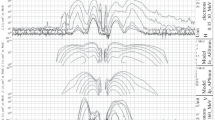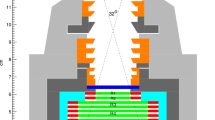Abstract
The Earth’s radiation belts discovered at the end of the 1950s have great scientific and practical interest. Their main characteristics in magnetically quiet periods are well known. However, the dynamics of the Earth’s radiation belts during magnetic storms and substorms, particularly the dynamics of relativistic electrons of the outer belt, when Earth’s radiation belt particle fluxes undergo significant time variations, is studied insufficiently. At present, principally new experiments have been performed and planned with the intention to better study the dynamics of the Earth’s radiation belts and to operationally control the space-energy distributions of the Earth’s radiation belt particle fluxes. In this paper, for spacecraft designed to measure the fluxes of electrons and protons of the Earth’s radiation belts at altitudes of 0.5–10000 km, the optimal versions for detector orientation and orbital parameters have been considered and selected.
Similar content being viewed by others
References
Vette, J.I., The AE-8 Trapped Electron Model Environment, Greenbelt, Maryland: National Space Science Data Center (NSSDC) World Data Center A for Rockets and Satellites (WDC-A-R&S), 1991.
Sawyer, D.M. and Vette, J.I., AP-8 Trapped Proton Environment for Solar Maximum and Solar Minimum (Tech. Rep. 76–06), Greenbelt, Maryland: National Space Science Data Center (NSSDC) World Data Center A for Rockets and Satellites (WDC-A-R&S), 1979.
Getselev, I.V., Gusev, A.A., Darchieva, L.A., et al., Model’ prostranstvenno-energeticheskogo raspredeleniya potokov zakhvachennykh chastits (protonov i elektronov) v radiatsionnykh poyasakh Zemli (Model of the Spatial and Energetic Distribution of Fluxes of Trapped Particles (Protons and Electrons) in the Earth’s Radiation Belts), Moscow: MGU, 1991.
Getselev, I.V., Sosnovets, E.N., Kovtyukh, A.S., et al., An empirical model of the radiation belt of Helium nuclei, Cosmic Res., 2005, vol. 43, no. 4, pp. 229–232.
Mullen, E.G., Gussenhoven, M.S., Ray, K., and Violet, M.A., A double-peaked inner radiation belt: Cause and effect as seen on CRRES, IEEE Trans. Nucl. Sci., 1991, vol. 38, pp. 1713–1718.
Roederer, J.G., Dynamics of Geomagnetically Trapped Radiation, New York: Springer, 1970.
Shabanskii, V.P., Yavleniya v okolozemnom prostranstve (Phenomena in the Near-Erath Space), Moscow: Nauka, 1972.
Williams, D.J., Arens, J.F., and Lanzerotti, L.J., Observations of trapped electrons at low and high altitudes, J. Geophys. Res., 1968, vol. 73, pp. 5673–5696. doi 10.1029/JA073i017p05673
Baker, D.N., Blake, J.B., Klebesadel, R.W., and Higbie, P.R., Highly relativistic electrons in the Earth’s outer magnetosphere: 1. Lifetimes and temporal history 1979–1984, J. Geophys. Res., 1986, vol. 91, pp. 4265–4276.
Williams, D.J., A 27-day periodicity in outer zone trapped electron intensities, J. Geophys. Res., 1966, vol. 71, pp. 1815–1826.
Li, X., Baker, D.N., Kanekal, S.G., et al., Long-term measurements of radiation belts by SAMPEX and their variations, Geophys. Res. Lett., 2001, vol. 28, pp. 3827–3830.
Gorchakov, E.V., Afanas’ev, V.G., Afanas’ev, K.G., et al., Study of fast charged particles with the help of a Cherenkov detector on the “Kosmos-900” artificial Earth satellite, Izv. Vyssh. Uchebn. Zaved., Fiz., 1987, no. 10, pp. 69–74.
Tverskaya, L.V., The latitude position dependence of the relativistic electron maximum as a function of Dst, Adv. Space Res., 1996, vol. 18, no. 8, pp. 135–138.
Kovtyukh, A.S., Storm deviations of the geomagnetic trap core from dipole configuration deduced from data on relativistic electrons, Cosmic Res., 2012, vol. 50, no. 3, pp. 226–232.
Reeves, G.D., McAdams, K.L., Friedel, R.H.W., and O’Brien, T.P., Acceleration and loss of relativistic electrons during geomagnetic storms, Geophys. Res. Lett., 2003, vol. 30, no. 10.
O’Brien, T.P., McPherron, R.L., Sornette, D., et al., Which magnetic storms produce relativistic electrons at geosynchronous orbit?, J. Geophys. Res., 2001, vol. 106, pp. 15533–15544.
Vlasova, N.A., Kovtyukh, A.S., Panasyuk, M.I., et al., Coupling between spatial, angular, and energetic distributions of particles on the geostationary orbit, Kosm. Issled., 1989, vol. 27, no. 1, pp. 94–101.
Kovtyukh, A.S., On the form of the energetic spectrum of protons in the Earth’s radiation belts and its formation mechanisms, Geomagn. Aeron., 1985, vol. 25, no. 6, pp. 886–892.
Kovtyukh, A.S., Solar-cycle variations of invariant parameters of ion energy spectra of the Earth’s radiation belts, Cosmic Res., 1999, vol. 37, no. 1, pp. 53–64.
Kovtyukh, A.S., Panasyuk, M.I., Reizman, S.Ya., and Sosnovets, E.N., Spectral characteristics of protons on low and high altitudes during the geomagnetic storm of July 29, 1977, Kosm. Issled., 1984, vol. 22, no. 3, pp. 399–405.
Kremser, G., Korth, A., Ullaland, S., et al., Energetic electron precipitation during a magnetospheric substorm and its relationship to wave particle interaction, J. Geophys. Res., 1986, vol. 91, pp. 5711–5718.
Imhof, W.L. and Nightingale, R.W., Relativistic electron enhancements observed over a range of L shells trapped at high altitudes and precipitating at low altitudes into the atmosphere, J. Geophys. Res., 1992, vol. 97, no. A5, pp. 6397–6403.
Kovtyukh, A.S., Coupling of pitch-angle and energetic distributions of ions in the Earth’s radiation belts, Geomagn. Aeron., 1993, vol. 33, no. 4, pp. 52–62.
Bashkirov, V.F. and Kovtyukh, A.S., Pitch-angle distributions of ions in the Earth’s radiation belts: 3. Mathematical model for the real magnetic field, Geomagn. Aeron., 1994, vol. 34, no. 2, pp. 29–37.
McIlwain, C.E., The radiation belts, natural and artificial, Science, 1963, vol. 142, pp. 355–361.
West, H.I., Jr. and Buck, R.M., Pitch angle distributions of energetic electrons in the equatorial regions of the outer magnetosphere—OGO-5 observations, in Magnetospheric Physics, McCormac, B.M., Ed., Dordrecht: D. Reidel, 1974, pp. 93–104.
Tverskoi, B.A., Dinamika radiatsionnykh poyasov Zemli (Dynamics of the Earth’s Radiation Belts), Moscow: Nauka, 1968.
Hess, W.N., The Radiation Belt and Magnetosphere, Waltham, Massachusetts: Blaisdell, 1968.
Schulz, M. and Lanzerotti, L.J., Particle Diffusion in the Radiation Belts, New York: Springer, 1974.
Akasofu, S.-I. and Chapman, S., Solar–Terrestrial Physics, Oxford: Clarendon, 1972; Moscow: Mir, 1975.
Kovtyukh, A.S. and Panasyuk, M.I., The radiation belts of the Earth, in Plazmennaya geliogeofizika (Plasma Heliogeophysics), Zelenyi, L.M. and Veselovskii, I.S., Eds., Moscow: Fizmatlit, 2008, vol. 1, pp. 510–534.
Vlasova, N.A., Ginzburg, E.A., Kalegaev, V.V., et al., Penetration of solar cosmic rays into the Earth’s magnetosphere on January 28, 2012, Cosmic Res., 2013, vol. 51, no. 5, pp. 319–325.
Sadovnichy, V.A., Panasyuk, M.I., Bobrovnikov, S.Yu., et al., First results of investigating the space environment onboard the Universitetskii-Tatyana Satellite, Cosmic Res., 2007, vol. 45, no. 4, pp. 273–387.
The Van Allen Probes Mission, Space Sci. Rev., 2013, vol. 179, nos. 1–4.
Author information
Authors and Affiliations
Corresponding author
Additional information
Original Russian Text © M.I. Panasyuk, M.V. Podzolko, A.S. Kovtyukh, I.A. Brilkov, N.A. Vlasova, V.V. Kalegaev, V.I. Osedlo, V.I. Tulupov, I.V. Yashin, 2017, published in Kosmicheskie Issledovaniya, 2017, Vol. 55, No. 2, pp. 85–93.
Rights and permissions
About this article
Cite this article
Panasyuk, M.I., Podzolko, M.V., Kovtyukh, A.S. et al. Optimization of measurements of the Earth’s radiation belt particle fluxes. Cosmic Res 55, 79–87 (2017). https://doi.org/10.1134/S0010952516060071
Received:
Published:
Issue Date:
DOI: https://doi.org/10.1134/S0010952516060071




